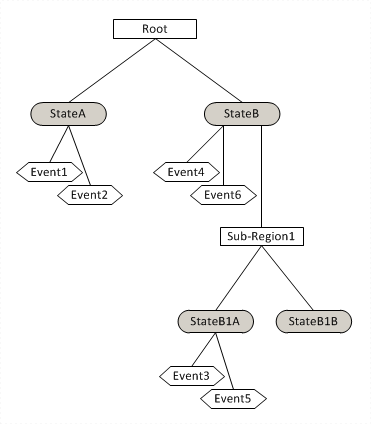| Composite States |
Describes how composite states and hierarchical state machines are created and how they function.
Hierarchical state machines allow to enclose a group of states within a composite state.
This introduces a bunch of new situations for transitions within a state machine. Regardless of the fact that transtions may start from or end on composite states, the state machine will transfer the active state of the state machine from a leaf simple state to (usually) another leaf simple state. For such cases the transition effectively crosses the border of the involved composite states which causes that the entry or exit actions of the composite state are executed additionally to the entry or exit actions of the ultimate leaf simple states.
The transition excution rules are as follows:
Targeting a sub-state of a composite state from outside of the composite state will execute the entry action of the composite state and then the entry action of the target state. The actions of the composite state are common for all sub-states.
Targeting a composite state at its border instead of a sub-state will enter the defined initial state of the enclosed group of sub-states, unless the history functionality is enabled.
Targeting a state outside of a composite state from one of its sub-states will execute the exit action of the leaf simple state and then the exit action of the composite state.
Starting a transition at the composite state will exit from any sub-state in case the state machine resides in a sub-state. Both the exit action of the sub-state and the exit action of the composite state will be executed.
Starting a transition from a sub-state and targeting a sub-state within the same composite state will execute only the exit and entry actions of the sub-states and not those of the composite state.
Starting a transition from a sub-state, leaving the composite state and re-entering a composite state (eventually the same) will execute the composition of all exit and entry actions of the involved states.
This transition attaches with a special aggregation symbol to the composite state, but the actual source state is a sub-state of the composite state. The aggregation symbol has two effects: First it defines to which state the transition belongs and which priority it has in case of conflicting transitions. Second it defines that the composite state shall be left and re-entered.


Sub-states of a composite state are added as a sequence of State..EndState statement pairs grouped through an embedding Region..EndRegion statement pair inside the composite state State..EndState statement pair, after any Transition statements of the composite state.
See below sample code:
StateMachineTemplate t = new StateMachineTemplate(); t.Region(StateA, false); t.State(StateA, null, null); t.Transition(Transit1, StateB1A, Event1, null, null); t.Transition(Transit2, StateB, Event2, null, null); t.EndState(); t.State(StateB, null, null); t.Transition(Transit4, StateA, Event4, null, null); t.Transition(Transit6, StateB1A, StateB1B, Event6, null, null); t.Region(StateB1A, false); t.State(StateB1A, null, null); t.Transition(Transit3, StateA, Event3, null, null); t.Transition(Transit5, StateB1B, Event5, null, null); t.EndState(); t.State(StateB1B, null, null); t.EndState(); t.EndRegion(); t.EndState(); t.EndRegion();
All transitions of the current state and its hierarchical ancestors are subject to be executed if their event arrives and/or the guard condition is fulfilled. In order to maintain a defined precedence across conflicting transitions, the transitions starting from the outer composite states take precedence over transitions starting from a sub-state.
Unlike the other transitions, Transit6 explicitly specifies the source state StateB1A to indicate that the transition starts from a sub-state of the state to which it is aggregated.
The history function tracks the most recently used state of a region and allows to enter this state when the state machine revisits the region.
The history function basically overrides the default initial state of the sub-region. The initial history state is the default initial state. When the state machine leaves the sub-region, the last active state within the sub-region is stored in the history. Transitions that target the border of the composite state will enter the last active state of the sub-region instead of the default initial state.
In case a defined initial state is needed for some transitions, these transitions can directly target the desired state within the sub-region.
The provided history function is most similar to the shallow history of the OMG UML Specification. In case a deep history is needed, all nested sub-regions shall recursively enable the history function.
The history function can be enabled through the hasHistory parameter of the Region statement.
A history for the Root Region instance is useless and thus not supported.